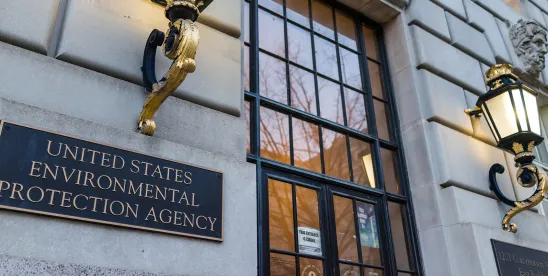While the Trump Administration has emphasized regulatory reform and prioritized agency efficiency across the federal government, EPA continues to pursue aggressive enforcement of the Federal Insecticide, Fungicide, and Rodenticide Act (FIFRA). Actions taken by EPA over the first six months of President Trump’s current term demonstrate sustained FIFRA enforcement, with notably high penalty amounts being assessed, including one case resulting in a $3 million penalty. These latest enforcement trends signal that pesticide manufacturers, distributors, and sellers must remain vigilant in complying with FIFRA requirements.
Environmental Enforcement Landscape
In the initial weeks of the Trump Administration, EPA and the Department of Justice (DOJ) took time to review enforcement actions ongoing from the Biden Administration and determine their new priorities. Within days of President Trump’s inauguration, DOJ temporarily froze all environmental litigation to allow for review and potential reconsideration of the new administration’s litigation positions. Similarly, on January 24, acting senior career leadership at EPA temporarily halted all communications with external parties—which effectively froze administrative enforcement—while incoming leadership began to review pending actions for consistency with administration policies. On February 19, President Trump issued an Executive Order (EO) titled Ensuring Lawful Governance and Implementing The President’s “Department Of Government Efficiency” Deregulatory Initiative. Among other things, that EO instructed agencies to “preserve their limited enforcement resources by generally deprioritizing” enforcement for rules that are “based on anything other than the best reading of a statute” or that go “beyond the powers vested in the Federal Government by the Constitution.”
On March 12, Jeffrey Hall, then-acting Assistant Administrator of EPA’s Office of Enforcement and Compliance Assurance (OECA) (and now President Trump’s nominee to permanently lead OECA), issued a memorandum to provide initial guidance on implementing the fiscal year 2024–2027 National Enforcement and Compliance Initiatives (NECIs) consistently with the February 19 EO (among others) and the Five Pillars of EPA Administrator Zeldin’s “Powering the Great American Comeback” Initiative.
After the initial temporary freeze and policy realignment, enforcement picked up, with case conclusions beginning to emerge, and the pace increasing over time. According to EPA, between January 20 and May 7, 2025, the Agency concluded 126 national-priority civil enforcement cases under the NECIs, an increase compared to 97 concluded cases over the same period last year. During that time, the Agency also opened 66 criminal cases (60 same period last year) and sentenced 43 criminal defendants (28 same period last year). By contrast, from January 20 through late June, DOJ had filed only three new environmental civil enforcement actions in federal court, compared to 60 cases opened during all of fiscal year 2024.
FIFRA Administrative Enforcement on the Rise
While the government has scaled back civil environmental enforcement in federal court, EPA’s administrative enforcement under FIFRA remains robust and appears to be accelerating. In the past two months alone, EPA has assessed its three largest penalties of the year so far, including one $3 million penalty and two $1.1 million penalties, in three separate actions. Nine additional settlements included six-figure penalties, and 19 more had five-figure amounts.
EPA has already assessed more FIFRA penalties in the first six months of this administration than it did in all of 2022 ($6.7 million) and 2023 ($7.09 million). If this pace continues, total penalties may exceed EPA’s 2021 high-water mark of $12.43 million, when enforcement surged due to Covid-related violations.
As of July 30, 2025, EPA had taken 122 administrative enforcement actions under FIFRA, including:
- 40 “expedited” settlement agreements (ESA), which are used to resolve easily correctable violations that do not pose significant health or environmental harm and offer a discounted, non-negotiable settlement in lieu of a formal administrative process. In January, EPA launched its FIFRA Pilot Program, which encourages resource prioritization through expedited resolution of cases involving certain minor FIFRA violations. Congruently, the ESAs on the docket resolved violations for failure to file annual pesticide production reports. Penalties have ranged from $300 to $4,000, with an average penalty of about $1,100.
- 40 consent agreements and final orders (CAFOs), which are legally enforceable agreements the Agency uses to resolve violations that exceed the capacity of an ESA, often for distributing or selling unregistered or misbranded pesticides. Other common violations include utilizing mislabeled bulk tanks and failure to file notices of arrival with U.S. Customs and Border Protection for imported products. Penalties have ranged from $3,000 to $3 million, with an average penalty of about $213,000.
- 42 Notices of Refusal of Admission (NRAs), all issued by EPA Region 8, denying entry of pesticide imports at the United States’ northern border (Montana or North Dakota) for distribution or sale of misbranded pesticides and failure to correctly file required reports.
These enforcement trends are noteworthy for several reasons. First, they demonstrate that FIFRA violations can carry steep penalties, particularly where one type of violation occurs on many separate occasions. For example, the $3 million penalty involved more than 2,000 instances of distributing or selling unregistered pesticides and over 1,400 violations of a Stop Sale, Use, or Removal Order. Second, despite the highly complex and technical nature of pesticide regulation, many FIFRA violations are relatively straightforward to investigate, prove, and penalize. This makes them easy targets for enforcement under current directives to preserve agency resources and prioritize administrative enforcement actions. Third, despite this year’s earlier enforcement pauses, these FIFRA settlements continue to be approved, even with penalties in the six- and seven-figure range.
The continued approvals likely reflect EPA’s view that FIFRA enforcement is considered part of EPA’s “core” enforcement work. FIFRA enforcement is not part of the NECIs, and was not addressed in OECA’s March 12 NECI memo. Focusing on core work is one of EPA Administrator Zeldin’s top priorities for the Agency.
Changes in Criminal Enforcement
On May 9, President Trump issued an EO titled Fighting Overcriminalization in Federal Regulations. That EO discourages enforcement of “criminal regulatory offenses,” stating that “prosecution of criminal regulatory offenses is most appropriate for persons who know or can be presumed to know what is prohibited or required by the regulation and willingly choose not to comply, thereby causing or risking substantial public harm.” In addition, the EO disfavors criminal remedies for strict liability offenses—i.e., offenses that do not require proof of intent or knowledge—and instead encourages agencies to prioritize civil or administrative enforcement to address them. Among other things, the EO directed agencies to publish in the Federal Register (1) within 45 days of the EO, criminal referral guidance;[1] and (2) within one year of the EO and annually thereafter, a comprehensive list of regulatory offenses that carry criminal penalties, including the statutory authority and the rationale for criminal enforcement.
Like many other federal environmental laws, FIFRA authorizes both civil and criminal penalties. And like many other federal environmental laws, FIFRA’s criminal liability is based on knowledge (or negligence)—not strict liability. Nearly all FIFRA’s criminal penalties are characterized as misdemeanors, though the statute does provide for one felony—where a registrant uses or reveals product formulation with an intent to defraud. Depending on the facts of a case, someone who violates FIFRA may also be subject to prosecution for other federal crimes under Title 18 of the U.S. Code, such as making false statements to the government, wire or mail fraud, and conspiracy.
Historically, FIFRA criminal enforcement has been limited, generally reserved for cases involving serious harm to the environment or human health, highly culpable or egregious conduct, or extremely toxic pesticides. EPA did, however, expand the use of its FIFRA criminal enforcement authority during the height of the Covid-19 pandemic to address the marked public health risks associated with potentially false or misleading anti-Covid claims on disinfectant products. To the extent EPA has continued its expanded FIFRA criminal enforcement practices since the height of the Covid pandemic, the EO may curtail those practices and cause the Agency to revert to pursuing civil enforcement in some cases.
While the EO may narrow the scope of EPA’s criminal enforcement, companies should not assume criminal exposure has been eliminated. Under the policy, EPA may still focus FIFRA criminal enforcement on intentional misconduct, egregious behavior, and violations that result in serious harm. The EO also does not reach federal crimes under Title 18, which, as noted, can arise in a FIFRA enforcement case.
Conclusion
Despite broader shifts in regulatory efforts and enforcement priorities, EPA remains fully committed to FIFRA enforcement. The first half of 2025 has already seen a significant number of administrative actions and substantial penalties. FIFRA noncompliance can result in serious consequences, including financial penalties, operational disruptions, and reputational harm. Regulated entities should proactively review their compliance programs and engage counsel early when responding to EPA inquiries or enforcement activity.
[1] On July 31, 2025, EPA published its referral guidance in the Federal Register. 90 Fed. Reg. 36,044. That guidance largely restates what EPA historically has considered as a matter of formal policy when referring alleged criminal regulatory offenses to DOJ (and when deciding whether to open a formal investigation in the first instance). According to the guidance, when deciding whether to make a criminal referral, the Agency should consider factors such as the harm or risk of harm from the alleged offense, the potential gain to the putative defendant from the offense, whether the putative defendant had any special knowledge, expertise, or license related to the rule or regulation at issue, and any evidence concerning the putative defendant’s awareness or lack thereof concerning the law.






 />i
/>i
